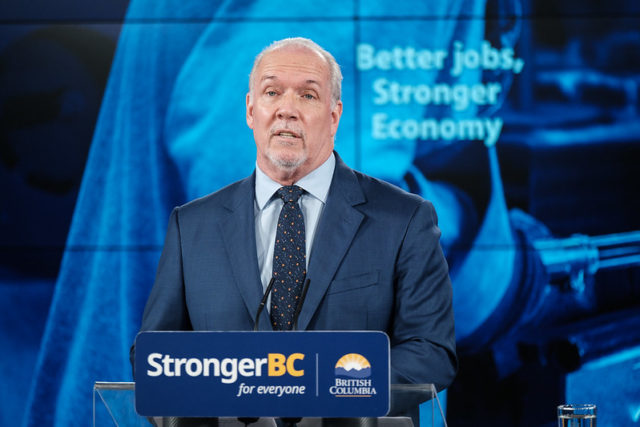B.C Premier John Horgan announced the launch of a made-in-B.C. certification system for skilled trades.
British Columbia has announced that it is launching a made-in-B.C. certification system for skilled trades workers, with automotive, heavy-duty, and autobody technicians selected to be among the first designated for certification.
The initiative is intended to support higher-paying, more stable work for trades workers and to help build the foundation of a strong economic recovery.
The new skilled trades certification system will help deliver steady employment for people and address the demand for skilled workers in B.C. It will also create more opportunities for women, Indigenous peoples and those just starting their careers, says the Province.
“Skilled tradespeople are building B.C., especially with the largest infrastructure investment in our province’s history already underway,” said Premier John Horgan.
“This is a made-in-B.C. solution to ensure confidence that a highly skilled workforce is behind our recovery while providing good, family-supporting jobs that tradespeople can count on. By working together, we’re ensuring B.C. comes out of the pandemic stronger, with a recovery that reaches people across the province.”
Every other province in Canada requires tradespeople to be certified, but B.C. removed that requirement in 2003.
Without a recognized credential, says the Province, it can be challenging for workers to transition between projects and industries, resulting in lost wages for workers and their families – especially for people who already face greater barriers to employment in the trades.
Among the benefits touted by the province:
- Skilled trades certification will enhance the strong industry and safety training system, which includes partnerships with WorkSafeBC and Technical Safety BC.
- Skilled trades certification will increase prestige for the trades, helping attract more people to trades careers. It will formally recognize the skills of current and future trades workers, helping them keep working as the economy and industry’s needs shift over time.
- Apprentices will be part of a certified workforce that will build the infrastructure and provide the services that British Columbians rely on every day. Following public consultation, implementation will start with 10 initial trades from electrical, mechanical and automotive disciplines.
“Skilled trades certification recognizes the professionalism of tradespeople throughout B.C., and ensures equity-deserving groups and every person who wants a rewarding career in the trades can access the highest level of education and training,” said Anne Kang, Minister of Advanced Education and Skills Training.
“Similar to a post-secondary degree, a certified trades worker has a certification that is recognized by employers – just like teachers, lab techs, nurses and other certified workers. By recognizing the worker’s skill, we will attract more people into careers in the trades in order to help address labour shortages across a variety of trades.”
Based on recommendations from a 16-member stakeholder advisory working group representing industry associations, labour, post-secondary institutions, Indigenous skills trainers and the Industry Training Authority, the 10 initial trades designated for skilled trades certification are:
- mechanical: gasfitter Class A and B, steamfitter/pipefitter, refrigeration and air conditioning mechanic and sheet metal worker;
- electrical: powerline technician, industrial electrician and electrician (construction); and
- automotive: heavy-duty equipment technician, automotive service technician and autobody and collision technician.
Once implemented, individuals in these 10 trades will be required to either be a certified journeyperson or a registered apprentice to work. To ensure high standards of supervision, safety and quality training for apprentices, government will also be working with industry to introduce journeyperson to apprentice ratios for each of these 10 trades, as in every other province. Key supports will be identified to support people during the transition to full certification.
A public engagement process will seek input on key aspects of implementing skilled trades certification, including:
- helping support current workers to become certified while standardizing skills at a high level;
- identifying and creating implementation supports for employers during economic recovery; and
- creating multiple pathways to completion for all workers, so no one is left behind.
The engagement will start immediately and includes an online survey, roundtables, community dialogues and focused discussions with the Industry Training Authority, the parliamentary secretary for skills training and staff from the Ministry of Advanced Education and Skills Training.
“Trades workers keep our lights on, the heating running and our vehicles safe, and deliver the services British Columbians count on,” said Andrew Mercier, Parliamentary Secretary for Skills Training. “That’s why we want to hear from current tradespeople, those interested in starting their careers and employers on how we can implement a new skilled trades certification system that meets the needs of people and economy today, with a support system that makes sense for both workers and employers. The conversation is ongoing, and we want to hear from you.”
Government will consult with apprentices, trades workers, small to large employers and Indigenous peoples, as well as asking for insight from women, new Canadians and other groups critical to growing the trades workforce about their experiences. These conversations will ensure representation from rural and urban communities.
Quick Facts:
- In 2003, the B.C. government eliminated compulsory trades credentialing system. This removed 11 compulsory trades and prescribed journeyperson-to-apprentice ratios.
- Skilled trades certification will be implemented in phases after the public engagement process is complete. Once a trade has been designated for certification, individuals will have at least one year to either register as apprentices or challenge an exam to certify as a journeyperson, allowing uncertified workers to continue working while accessing any additional supports they may need to.
- Approximately 73,000 job openings are expected in the trades in B.C. through to 2029. With 77% of these openings replacing retiring trades workers, skilled trades certification will help ensure the success of the individuals who will fill these roles, while continuing to build prestige around trades for those already working in them.
Learn More:
For skilled trades certification information, business cases and a public survey, visit: engage.gov.bc.ca/skilledtrades


0 Comments